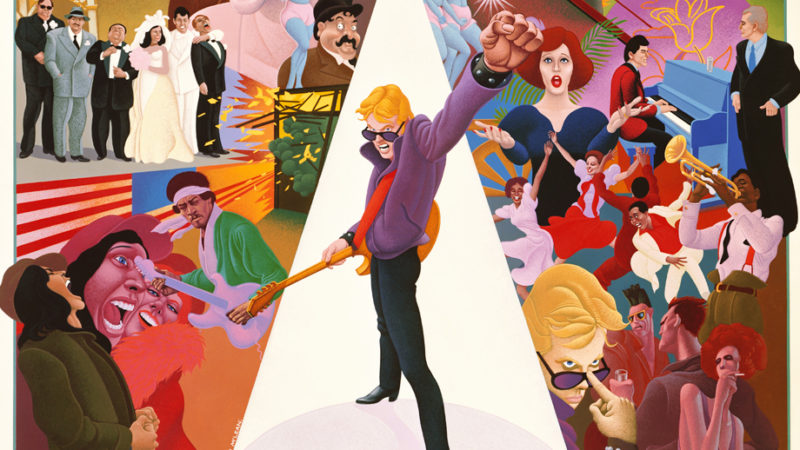Technical Revisions April: Blender 2.91, Stan Winston School of Character Arts, and FXPHD

Blender 2.91
Learning to be a 3D artist involves understanding technique, workflow and best practices rather than knowing specific programs. Sure, you can dive into Maya or Houdini or 3ds Max or Cinema 4D, etc. But as a budding artist, the cost of these programs may be out of your price range. This is where Blender comes in - it's robust, comprehensive, actually used in production, and it's open source, which means it's totally free.
Blender 2.91 is the latest build and, frankly, I'm a little embarrassed that I didn't give it the attention it deserves. The list of features is exhaustive and ranges from modeling to sculpting, to animation, from fabric to volumes, to things that other 3D programs have very little of: internal compositing, tracking, editing and hybrid 2D / 3D drawing tools.
For me, some of the brightest highlights in 2.91 are as follows: The Grease Pencil feature is designed for 2D animation, while it exists in 3D space. Strokes become editable objects. Plus, traditional 2D tools like onion peel provide a familiar workflow. New features in Grease Pencil in 2.91 include the ability to import black and white images and convert them to Grease Pencil objects. Additionally, you can paint masks that will act as a hindrance between the foreground and background animations.
Cloth tools were introduced in previous versions, but the developers have expanded this functionality even further. The cloth sculpture has been made more robust by including collisions. Users already had ways to pull surfaces around to create wrinkles and warps in the fabric while maintaining the surface, but collisions now allow fabric to be draped over characters.
There are also sophisticated effects with volumes where you can convert fluid volumes to mesh or vice versa, mesh to volumes. And you can move these volumes with procedural textures.
The list could go on and on. But, despite the fact that a Blender review is long overdue, and I'm glossing over just how powerful the program is, my main reason for bringing it up now - in an education-focused issue - is how accessible it is. Anyone with a computer can use it, which means anyone can learn 3D (and 2D) animation without the expense of a software license. While there are many educational or independent licensing offers of competing 3D programs, $ 750 may still be out of reach for someone just starting out. Blender removes these limitations.
As a helpful tip that I applied frequently when I was starting out, I used tutorials from other software packages and learned how to run them in the package I was using. For example: I had initially learned 3ds Max, so when Maya was released, I would use Max's tutorials to force me to rethink the approach and recreate it in Maya. Blender is as powerful as most other programs out there. There are hundreds of hours of training for this. But try watching Maya or Cinema 4D or 3ds Max tutorials and try to recreate them in Blender. This way, you learn the techniques and methodology for working in 3D and not just where the correct buttons are in the software.
Website: blender.org
Price: free!
Stan Winston School of Character Arts
Let's get away strictly from animation and visual effects, at least from a digital perspective, and move on to the practical side of things: special effects, creatures, miniatures and puppets. In this world of CG domination, we sometimes lose track of our brothers and sisters doing things for real. These exceptionally talented artists have skills that have been developed through apprenticeships and experience.
So where would you go to learn these skills? If you go to Best Buy and buy a computer, you have taken the first step in becoming a digital artist. All that is needed now is 10.000 hours of computer work. To actually make a thing, there is a lot more to do. There's clay, silicone, metalworking, armor forging, and more than just opening ZBrush and starting sculpting.
Fortunately, the late Stan Winston - one of the kings of practical effects - has an eponymous School of Character Arts online, which has hundreds of hours of training material covering everything from design to prosthetics, animatronics, wigs (! ) To sculpture and beyond. The courses are taught by people who are actually doing it in movies and on television and using the latest techniques. Brain confidence is vast.
Similar to something like Pluralsight, you can search for the exact tutorial you are looking for, but the real power lies in the Pathways, where you are guided through a series of courses as a deep dive into a particular topic: Design, Fabrication, Eyes, Teeth, Model Making , model making, filmmaking, etc. I love this approach because you are learning it as a skill and a trade, rather than simply solving a problem.
Furthermore, the community on the school website is active and very responsive. Instructors interact with students when they have questions. Students interact with each other. So, the knowledge doesn't come strictly from tutorials - you're getting feedback from your peers, just like in school.
In fact, I'm a member of the School not because I want to change careers and be a special effects artist (as opposed to visual effects), but rather because I need to know what these guys can (and can't) do, so that we can work. together to take advantage of each other's strengths. Knowledge also allows me to understand the language of their world so that I can communicate better.
For those on the digital side of things, you can learn a lot from making real things. Sculpting in clay gives you more understanding when sculpting in ZBrush. Wig Design provides information on hair care in XGen. Making real clothes helps Marvelous Designer artists. Painting real miniatures helps texture artists. Not to mention the way digital models work with 3D printers that provide pieces for making special effects, as well as computer assistance when designing animatronics. There is a lot to learn!
Website: stanwinstonschool.com
Price: $ 19,99 (monthly basis), $ 59,99 (monthly premium), $ 359,94 (yearly)
 FXPH extension
FXPH extensionFXPH extension
It's been a good five years since I last did a review on FXPHD and I have continued to be a paying member ever since because I feel the content is so good for VFX artists who are looking to improve their game.
FXPHD works on a subscription model, where you get access to almost any course at any time for a monthly fee. These courses range from related beginners to artists who have been in the field for years. And they span a myriad of techniques (compositing, modeling, sculpting, animation, effects, environments, matte painting, editing, tracking, you name it) and through even more software packages (Maya, Nuke, Houdini, Cinema 4D, After Effects, ZBrush, Photoshop, Katana, Clarisse, RenderMan, etc., etc., etc.).
There are also in-depth color grading courses in Resolve for an additional fee. But believe me, they are worth it. Frankly, I believe that every visual effects artist should take at least one rudimentary course in color grading.
The courses are all taught by instructors who have been and still are in the industry, using the same techniques in the actual production workflows they are teaching you. My favorite is probably Victor Perez, a visual effects supervisor in Mexico whose knowledge is deep and his presentation is broad. If you want to learn more about how to pull green screens rather than throwing a key light and sampling color, Victor explains not only which tools to use, but why, mathematically, you choose to use those tools. And this kind of approach embraces the courses: it's not just about how, but about because.
Yes, the content is great. Your FXPHD subscription gives you a VPN license for many of the software packages you are learning. Houdini and NukeX (as well as most other software) come at a high price if you're just starting to learn and aren't making money on your skillset yet. FXPHD gives you the tools to learn. There are many training sites on the internet, but I can't think of any that offer this kind of benefit.
Recently, I supervised a 360-degree video shoot, which I knew nothing about. FXPHD was my first stop to start using the techniques before the project started and I had to at least look like I knew what I was doing. One of the courses partially taught by visual effects veteran Scott Squires. (Look for him! He did a couple of things.)
So whether you're just starting out or you're a year veteran, the industry never stops changing and we never stop learning. FXPHD has been and will continue to be one of my main sources for keeping my skills on the cutting edge.
Website: fxphd.com
Price: Starting at $ 79,99 (monthly)
Todd Sheridan Perry is an award-winning visual effects supervisor and digital artist whose credits include Black Panther, The Avengers: Age of Ultron e The Christmas Chronicles. You can reach him at todd@teaspoonvfx.com.
Go to the source of the article on www.animationmagazine.net






